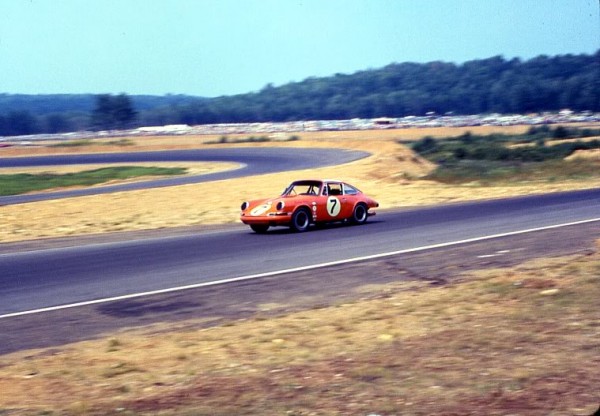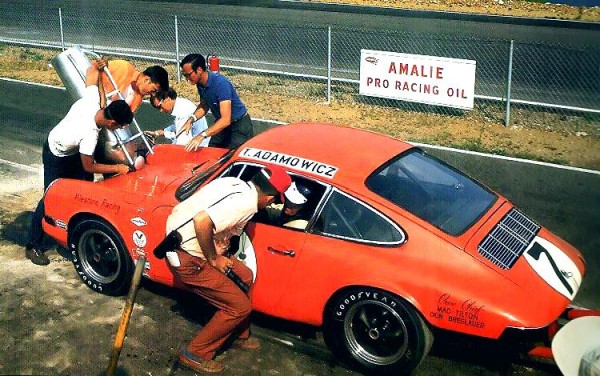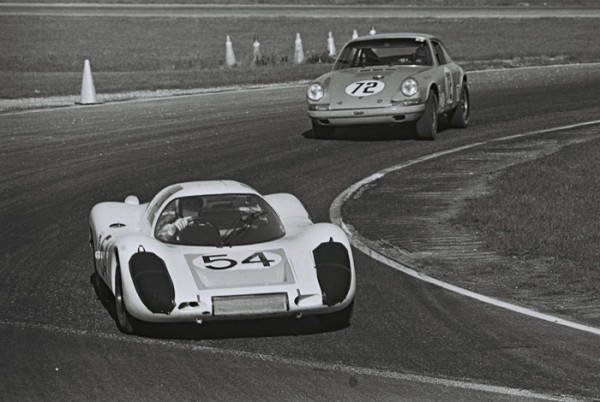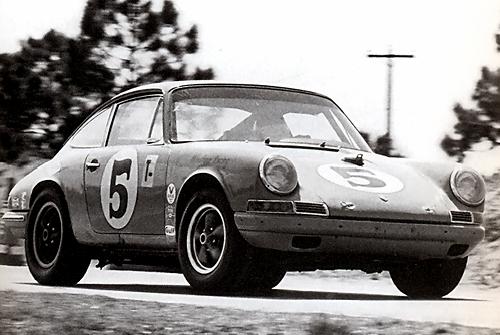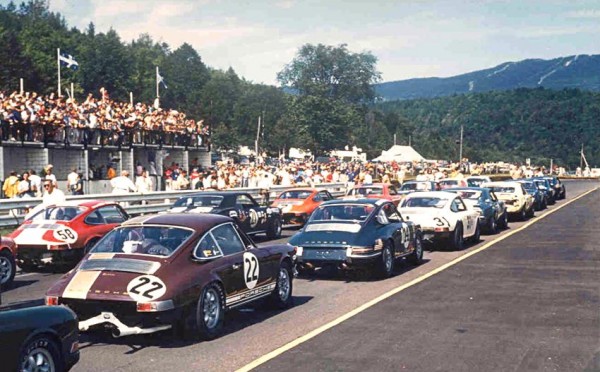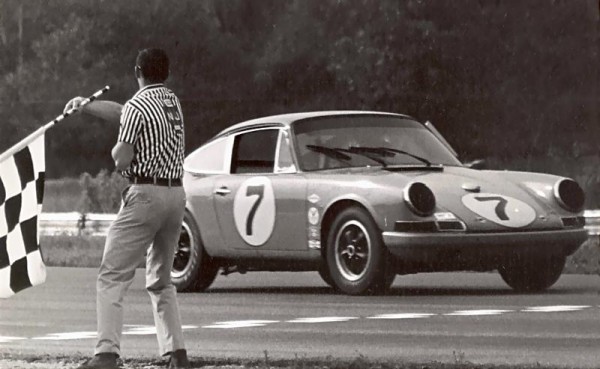The Sports Car Club of America began a new championship in 1966, known as the “Trans-American Sedan Championship”. At its inception, the Trans Am series was developed to provide FIA Group 2 Sedans up to 5 liters, with an annual production over 1000 units a place to compete on a “nearly showroom stock” level. The championship was split into two classes, above 2 liters, and under 2 liters. Critically, Porsche of America lobbied with the SCCA to have the 911 classified as a “sedan” for the 1967 championship.
Having seen how successful the 911 was in competition, having won the 1967 Trans Am U2L championship over Alfa Romeo (winning 7 of 12 events), Marvin Davidson made the decision to jump on the flat-six bandwagon for 1968. Mr. Davidson founded Milestone Racing, drafting mechanics Mac Tilton and Bill Contois, a youthful Don Breslauer, PR agent Tony Muldoon, and driver Tony Adamowicz, along with his wife, Sally Davidson, to complete the team. Headquartered in a Sunoco service station in Wilton, CT, the team derived its name from the stone marker on the side of Route 7 right out front.
The team had assembled a gorgeous Tangerine machine with which to enact their ’68 season assault, and arrived at the opening round of the championship, which was to run concurrent with the 1968 Daytona 24 hour event, as prepared as they could have been. With a giant number 72 painted on the side, it was clean car, clearly built from the ground up to be a racer. At the time, Porsche still viewed the 911 as unfit for circuit competition, preferring to promote the relatively new car through rallying and hillclimbing in Europe. It was because of this that Milestone Racing had found it necessary to fabricate many bespoke components for the season. The car was prepared with stiffer suspension bushings, thicker sway bars, and larger torsion bars.
In the late sixties, when safety was less of a concern, it was not uncommon for 24 hour endurance events to be completed by only a pair of drivers. In the case of Milestone v. Daytona, team owner Davidson shared driving duties with Adamowicz. Perhaps it was this 12-hours-each driving that caused Mr. Davidson to incur a late night accident. Regardless, the accident rendered their well-prepared 911 completely useless, and they trucked home to Connecticut to begin preparations for the second round the following month.
While most of their bespoke racing components could be salvaged, the body shell was a complete write-off. Working under strict time constraints, and with a budget to consider, the crew sourced a mostly stripped, but solid body shell from the New York City police impound. The car, as it turned out, was a 912 shell originally painted Irish Green, and needed a little work to swallow the 2.0 liter flat-six and some paint to arrive in the team’s signature Tangerine. The team hurried the project, but took their time where necessary, as the second event, a 3 hour race at Sebring, loomed.
Sebring, like Daytona, did not pay off for Milestone. The team discovered, too late, that their stock tachometer was not calibrated correctly, and was reading lower than what the engine was spinning. Just past half way, after 28 laps of inadvertent over-revving abuse, the flat-six gave up the ghost, coasting the orange #5 912-6 to a halt on the track, and ending the team’s day early. Starting the season with two DNF results wasn’t exactly what the team was looking for, but ever the optimists, they kept going.
Knowing that they needed an advantage on the competition, the team did everything they could to eke one out. The car was outfitted with a dry-break oil line system, and the engine compartment harness was routed through a spin-off style cannon plug at the firewall, thus facilitating and easy installation and removal of the drivetrain. In preparation for the remainder of the season, the team replaced the OE tachometer with a cable driven aftermarket unit, combined with the installation of a rev limiter, the team knew they wouldn’t spin the new engine high enough to explode again. Perhaps needing a little bit of luck, the team adorned the car with a large, elegant, number 7.
Milestone, as a team, formed a cooperative relationship with one of the Over 2 Liter class runners in the form of the AMC factory Javelin effort. AMC had the budget to rent courses out for testing that Milestone simply couldn’t afford. Meanwhile, Milestone provided the AMC team with relevant tire and cornering speed data, as well as wheel-to-wheel practice running that they needed. This testing, combined with the team’s ability to remove their drivetrain in about 20 minutes, allowed Milestone to try out several different gearing packages, and build their gearboxes to suit each track on the schedule. Milestone were known later in the season for their quick changes, sometimes changing ratios as many as 4 times during the course of an event weekend.
Round 3 at War Bonnet Park netted some of the luck and a better result for the team, with a second place finish in class. The podium finish gave Adamowicz and his team the shot in the arm they needed, and spirits were lifted. It was at Lime Rock Park, however, where Tony A-to-Z gave the team their first class victory, leading a Porsche 1-2-3 in the Under 2 Liter category. Another second place position at Mid-Ohio in June, again part of a 1-2-3 for Porsche, cemented the team’s position at the front of the field. Preparation, some blind luck, and a good driver had brought them out of the early season slump and in good standing.
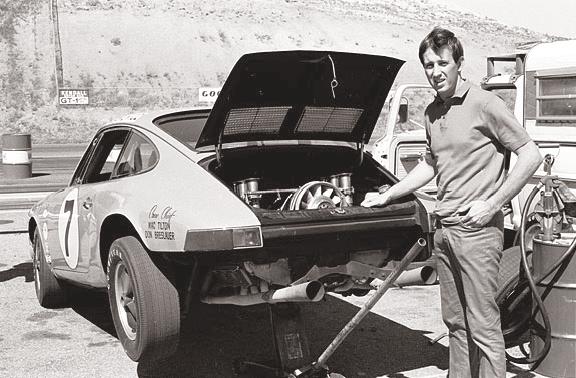
Part time mechanic and part time driver, Tony Adamowicz prepares his steed for a famous gear swap at the continental divide event late in the season.
The season then progressed through Bridgehampton, New York, Meadowdale, Illinois, Mont Tremblant in Quebec, Loudon, New Hampshire, and Watkins Glen, New York with Tony Adamowicz taking the victory in each of these events. Five victories in a row had netted Porsche the Trans Am Challenge U2 class championship, with all others being mathematically ineligible. Porsche privateers had shown that the 911 was competitive on the world stage of circuit racing two years in a row, and in 1968 it was Adamowicz and Milestone that proved it.
Following their final victory at Watkins, things started looking bleak again. A trip West to the Continental Divide Raceway in Castle Rock, Colorado late in August netted the team an engine failure 31 laps into the event. Just two weeks later, another engine failed, this one lasting 78 laps of the Riverside Raceway in Southern California. The final event of the season, held at Pacific Raceways in Kent, Washington, was run without the familiar orange 912, as the team had decided to pack it in for the season. They had taken their punches, and delivered a few of their own.
The manufacturers championship points system for the 1968 season awarded 9 points for each victory, and only awarded points to the highest placed car from each make. Manufacturers were only held responsible for their 10 best results of the 13 race season, and as such, Porsche privateers scored 10 victories (other Porsche drivers were victorious at Daytona, Sebring, Mid-Ohio, and the Continental Divide) to garner the German manufacturer a perfect 90 point season. The three events in which Porsche failed to win, Alfa Romeo won, but still couldn’t even manage half as many points as the Porsche driving victors.
Following the 1968 season, the victorious 912-6 was sold to competitor Herb Wetanson, who used the car for a 1969 Trans Am event at Michigan. From there, it is unclear as to where the car went, and with most old race cars, it seems to have simply faded into the ether. Unfortunately, neither Adamowicz nor anyone else in the Milestone garage seems to have taken note of the car’s chassis number, and as such we may never find the “true” Milestone Trans Am victor.
[Photography courtesy Pete Lyons, Pete Luongo, Dave Freidman, and Dave Nadig via A2Zracer.com]
